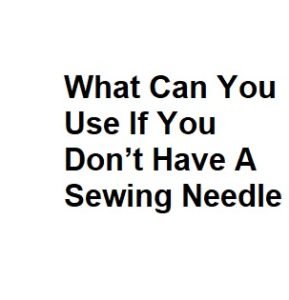Sewing needles are essential tools for various sewing and mending tasks, but there may be situations where you find yourself without one. Whether you’re in a crafting emergency or a survival situation, there are several creative alternatives you can use as makeshift sewing tools. In this guide, we’ll explore various items and techniques you can employ when you don’t have a sewing needle on hand.
1. Safety Pins
Safety pins are readily available in most households and can serve as a great alternative to sewing needles. They are particularly useful for temporary fixes and quick repairs. To use a safety pin for sewing:
- Thread the fabric through the open end of the safety pin.
- Carefully push the pin through the fabric, creating a simple stitch.
- Repeat as necessary, and then secure the ends by wrapping the thread around the fabric.
2. Paperclips
Paperclips are another common office supply item that can be repurposed as a makeshift sewing tool. To use a paperclip for sewing:
- Straighten out the paperclip as much as possible.
- Bend one end into a small loop to serve as an eye for threading.
- Use the straightened portion to sew through the fabric, creating stitches.
- Secure the thread at the end by tying it tightly.
3. Hairpins or Bobby Pins
Hairpins or bobby pins can be used in a pinch for sewing lightweight fabrics or minor clothing repairs. Here’s how:
- Thread the fabric through the looped end of the hairpin.
- Push the hairpin through the fabric as you would with a needle.
- Create stitches by looping the thread through the hairpin and fabric.
- Knot the thread securely at the end.
4. Dental Floss
Dental floss is a strong and durable thread that can substitute for traditional sewing thread. To use dental floss for sewing:
- Fold a piece of dental floss in half to double its strength.
- Thread it through the eye of a paperclip, hairpin, or a makeshift needle.
- Sew through the fabric, creating your stitches.
- Knot the ends to secure your work.
5. Clothespins
Clothespins can be used for securing fabrics together temporarily. While they won’t sew, they can hold fabrics in place until you can access proper sewing tools.
6. Glue
In some cases, fabric glue can be a temporary fix for minor tears or seams. Apply a small amount of fabric glue to the area in need of repair, press the fabric together, and allow it to dry.
7. Hand-Sewing Techniques
In the absence of a needle, you can employ basic hand-sewing techniques using your fingers. This method is suitable for very light fabrics or emergency situations:
- Use your fingers to pinch and hold the fabric together.
- Thread your substitute tool (e.g., paperclip, hairpin) with a length of thread.
- Push the tool through the fabric while keeping it pinched.
- Create stitches by looping the thread through the tool and fabric.
- Knot the thread at the end to secure the repair.
8. Repurposed Items
Be creative and look for items in your surroundings that may serve as makeshift sewing tools. For example, a thorn from a plant, a small twig, or a piece of wire can be used to push thread through fabric when in a survival situation.
While these alternatives can help you sew without a traditional needle, keep in mind that they may not be as efficient or durable as actual sewing tools. They are best suited for temporary fixes or emergency situations. It’s always advisable to have a well-equipped sewing kit on hand for more serious sewing and mending tasks.
